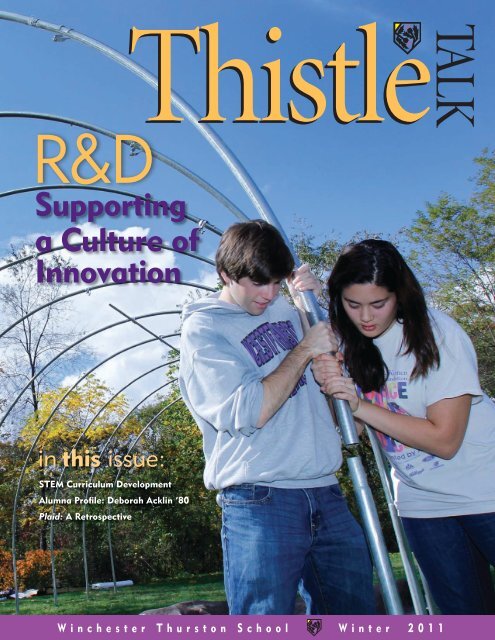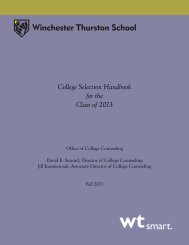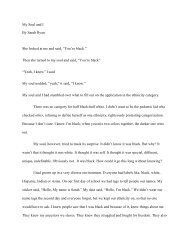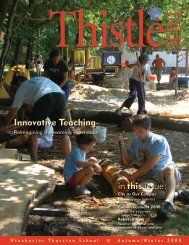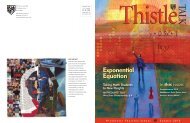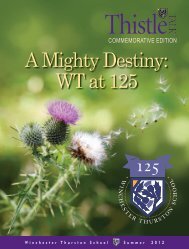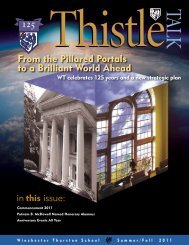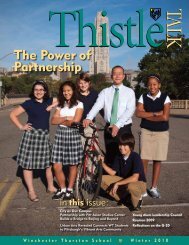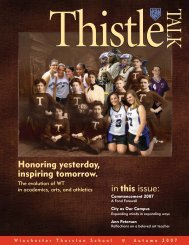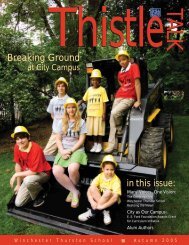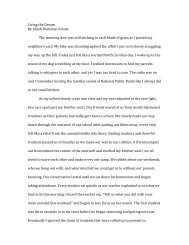Thistletalk Winter 2011 - Winchester Thurston School
Thistletalk Winter 2011 - Winchester Thurston School
Thistletalk Winter 2011 - Winchester Thurston School
- No tags were found...
Create successful ePaper yourself
Turn your PDF publications into a flip-book with our unique Google optimized e-Paper software.
R&DThistleTALKSupportinga Culture ofInnovationin this issue:STEM Curriculum DevelopmentAlumna Profile: Deborah Acklin ‘80Plaid: A RetrospectiveW i n c h e s t e r T h u r s t o n S c h o o l W i n t e r 2 0 1 1
contentsCultivating Young Innovatorsthrough Educational InnovationFROM THE HEAD OF SCHOOL Gary J. Niels 2New Faces on the Board 3COVER STORY:R&D at WT:Supporting a Culture of Innovation 4STEM: What Should a Dynamic Pre-K ThroughGrade 12 STEM Program Look Like? 8DEVELOPMENT & ALUMNAE/I NEWS:WT on the Road in Chicago 21Reunion 2010 22Lida B. JohnstonExcellence in Latin Awardand the Miss Mitchell Society 24Reaching across Borders 254Class Notes 26In Memoriam 32WT TODAY:SCHOOL NEWS Fall Highlights…WT Alumnaand Trustee Deborah Acklin ’80...Geocaching...Plaid...Lower <strong>School</strong> Science Days...Fall SportsRoundup…Faculty News102025www.winchesterthurston.org 1
Cultivating Young Innovatorsthrough Educational InnovationGary J. NielsThere has been a recent explosion ofinterest in educational innovation.It is reflective of our world: thenanosecond pace of technologicalchange and the mind boggling vistas ofopportunity that emerge before our eyes.<strong>School</strong>s all over the nation are seeking tounderstand how they can best preparestudents for a world of innovation, andhow they themselves can be innovative.<strong>Winchester</strong> <strong>Thurston</strong> has been anenthusiastic participant in this quest—and indeed, we seek to be a leader incultivating young innovators with theskills and dispositions to thrive and leadin an unscripted world.The process of stirring innovationwithin our school by thinkingfuturistically has been one of the goalsof our Advisory Board. One of the mostprofound contributions of the AdvisoryBoard has been its assistance in imagininghow we could expand and enhance Cityas Our Campus. Their ideas became partof our proposal to the Edward E. FordFoundation, which resulted in our beingone of only four schools selected for a2009 Leadership Grant. In addition tothe programming the grant has enabledus to institute, it has connected us withpremier independent schools in thenation and world, which have also beennamed recipients of the Edward E. FordFoundation Leadership Grant.Last spring I was honored when BillChrist, Head of Hathaway Brown <strong>School</strong>in Cleveland, Ohio, contacted me andasked <strong>Winchester</strong> <strong>Thurston</strong> <strong>School</strong> topresent at their national InnovationSummit (part of their 2008 Edward E.Ford Foundation Leadership Grant), tobe held in the fall of 2010. The Summit’spurpose was to provide a forum and asource of inspiration and knowledge toIt was exciting and fun to have a roomfull of educators responding to the workWT has done, asking questions, andengaging with us.Of course, <strong>Winchester</strong> <strong>Thurston</strong>has always been and will continue tobe a college preparatory school. Thismeans that our curriculum is based inthe liberal arts. We desire our studentsto be schooled in the fundamental“<strong>School</strong>s...are seeking to understand how they can bestprepare students for a world of innovation...<strong>Winchester</strong><strong>Thurston</strong> has been an enthusiastic participant in thisquest — and indeed, we seek to be a leader in cultivatingyoung innovators with the skills and dispositions to thriveand lead in an unscripted world.”independent school teachers and leaders,to increase the innovation taking place inour schools. I attended the Summit withMick Gee, our Upper <strong>School</strong> Director,and Teresa DeFlitch, our City As OurCampus Director. It was an impressiveevent with many important thinkersand leaders. Keynote addresses weregiven by bestselling author Daniel Pink,who spoke on the findings recordedin his latest book Drive: the SurprisingTruth of What Motivates Us, and LizColeman, President of BenningtonCollege, who spoke about a new kind of21st century education. Moreover, theworkshops included everything from“the origins of transformative ideas” to“the neuroscience of talent” to “the secretsauce of innovative schools” to “liberatingthe innovator within.”In WT’s workshop, we discussedthe origin and evolution of City as OurCampus, its relationship to our missionand location, emerging curricularinitiatives, as well as the systemic andphilosophical obstacles to fully embracinginnovation as our core educational value.disciplines, and believe that collegesdo, too. Our Upper <strong>School</strong> curriculumrequires a minimum of four years ofEnglish, four years of social studies,three years of mathematics, three yearsof the same foreign language, and threeyears of laboratory science. Moreover,we require visual and performing arts.These are minimum expectations andnearly all of our students exceed theserequirements. It is important to notethat WT’s innovation operates withinthis context of academic rigor.The theme of this issue of <strong>Thistletalk</strong>is innovation. It illustrates how ourteachers are being innovative and howwe seek to cultivate innovation as aquality that our graduates possess. Theblend of a rigorous liberal arts curriculuminfused with innovation is one of thespecial qualities that contributes to theexcellence of <strong>Winchester</strong> <strong>Thurston</strong>.2 <strong>Thistletalk</strong> <strong>Winter</strong> <strong>2011</strong>
New Faces onthe BoardSimin Yazdgerdi CurtisWT parent Simin Curtis returns for asecond term on the Board. She is Presidentand founder of the Pittsburgh Middle EastInstitute (PMEI), anon-profit consortiumpromoting business,educational, andcultural ties betweenPittsburgh and MiddleEastern countries.PMEI has hosted threeannual conferences,bringing to PittsburghThomas Friedman(2008), Fareed Zakaria(2009), and Madeleine Albright (2010). Lastspring, Curtis led a delegation of Pittsburghcompanies and universities to Oman asspecial guests of the Ministry of ForeignAffairs. She has been invited to serve asHonorary Consul of the Sultanate of Omanin Pittsburgh and is on the World AffairsCouncil of Pittsburgh Board. Prior to startingPMEI, Curtis served as Vice President ofMarketing for the investment advisory firmGreycourt & Co., Inc. A graduate of Harvard,Curtis is past director of the Harvard AlumniAssociation, past President of the HarvardClub of Western Pennsylvania and theHarvard-Yale-Princeton Club, and co-founderof Ellsworth Avenue Business Association.Ilana DiamondWT parent Ilana Diamond is President andCEO of Sima Products Corporation, whichhas earned more than 20 industry awards forinnovative engineering and product design,and received a “BlueChip Enterprise” awardfrom the U.S. Chamberof Commerce. Priorto joining Sima in1993, Diamond spentseven years as SeniorManager of MiddleMarket BusinessAdvisory Services inPrice Waterhouse’smanagementconsulting division, and held sales andmarketing positions with AT&T andMotorola. Diamond earned her Master ofManagement degree from NorthwesternUniversity’s Kellogg Graduate <strong>School</strong> ofManagement and holds a B.A. in Economicsfrom Northwestern University. Diamondserves as Vice Chair of the Pittsburgh JewishCommunity Center Board of Directors, isa charter member of TIE Pittsburgh, anda Partner Emeritus of Pittsburgh SocialVenture Partners. Nationally, Diamond serveson the Consumer Electronics AssociationDivision Executive Board, Board of IndustryLeaders, and as Accessories Board Vice Chair.Kathleen Metinko ‘91WT alumna Kathleen L. Metinko is aprincipal in the Special Acquisition Servicesgroup of Deloitte Tax LLP, where shespecializes in mergers and acquisitions forprivate equity clients.She was admitted topartnership in 2007.After graduatingfrom WT, Metinkoreceived her B.S.in finance, summacum laude, f romDuquesne University;J.D., cum laude, fromthe University ofPittsburgh <strong>School</strong> ofLaw, and LL.M. in taxation from the NewYork University <strong>School</strong> of Law. Metinko isa member of the Pennsylvania State BarAssociation and the New York State BarAssociation’s Tax Section. She is also aCertified Public Accountant. She is an activemember of the Youth, I.N.C. ConsultingAdvisory Board, and served as a Trusteeof the Brooklyn Music <strong>School</strong> (2003-2007).Prior to relocating to New York in 2000, shewas a member of the Board of Directors ofPittsburgh Young Professionals and chair ofits Esprit De Corps event.Deesha PhilyawWT parent Deesha Philyaw joins the WTBoard after two years as Parents Associationpresident. A freelance writer whose workhas appeared in Essence, The WashingtonPost, and numerous anthologies, Philyaw isan adjunct professor at Chatham Universityand an instructor at the Pittsburgh Centerfor the Arts. She cofounded (with her exhusband)CoParenting101.org, a resourcefor those who are parenting together afterdivorce or separation.She co-hosts onlinetalk show “Co-Parenting Matters”on BlogTalk Radio;serves as co-parentingcolumnist for the newmediajournal TheFaster Times, and is acolumnist at the onlineparenting resourceLoveIsntEnough.com.Philyaw holds a Master’s degree in teachingfrom Manhattanville University, and a B.A. inEconomics from Yale.<strong>Winchester</strong> <strong>Thurston</strong> <strong>School</strong>BOARD OFTRUSTEES2010-<strong>2011</strong>Henry Posner III, PresidentRalph L. Bangs, Vice PresidentKathleen W. Buechel, Vice PresidentDouglas A. Campbell, Vice PresidentDusty Elias Kirk, SecretaryStephen G. Robinson, TreasurerElizabeth S. Hurtt ‘74, Assistant TreasurerGary J. Niels, Head of <strong>School</strong>Deborah L. Acklin ’80Ronald J. BartlettBarbara Abney Bolger ’52John B. Christie-SearlesSimin Yazdgerdi CurtisIlana DiamondRobert I. GlimcherRosanne Isay Harrison ’56 ◊Diane P. HolderIan JamesDeepak KotwalElsa LimbachSteve LoevnerCarole Oswald Markus ’57 ◊Linnea Pearson McQuiston ’69Kathleen L. Metinko ’91Douglas H. OstrowDeesha PhilyawDavid L. PorgesMartin E. PowellSusan Santa Cruz ’60Nancy T. ScottJane Arensberg Thompson ’57 ◊◊Emeritus Trusteewww.winchesterthurston.org3
cover storyR&D at WTSupporting a Culture of InnovationFaculty innovation is the heart of City as Our Campus, and ideas are its lifeblood.Like corporations, universities, and think tanks, through R&D WT has createdintentional and deliberate ways to keep ideas pulsing through the pipeline.Imagine a world without wrinkle-freecotton, the remote control, smartphones,ear thermometers, MRI, water filters,smoke detectors, or global positioningsystems. These and innumerable otheraspects of modern life, which many of ustake for granted, exist because of researchand development, or R&D—processesinitiated by companies to deliberately andintentionally innovate.Now, <strong>Winchester</strong> <strong>Thurston</strong> is applyingthe principles and practices of R&D to itsCity as Our Campus initiative, activelysoliciting—and supporting—innovation inall divisions via a new R&D faculty grant.“Companies that encourage employeesto be creative, whether through formalR&D programs or exploratory designteams, often make the most innovativediscoveries,” states City as Our CampusDirector Teresa DeFlitch. “For example,IDEO, an award-winning design firm, hasdeveloped numerous innovations—suchas the computer mouse and the portabledefibrillator—through its program ofemployee discovery. We want to fosterthe same type of idea generation andimplementation for both our faculty andour students.”Photo, above: As part of the new Urban Research and Design course, seniors explore the realworld challenges of urban poverty, hunger, and food security. In the fall, they constructed a hoophouse measuring 20 feet wide by 36 feet long feet, and standing 12 feet tall, to grow producethat will be donated to local food banks.R&D Grants SupportFaculty InnovationThe R&D grant is a new feature of Cityas Our Campus, funded in part by theEdward E. Ford Foundation. Its purposeis to support faculty who want to exploreand develop ideas to build City as OurCampus experiences and programs intotheir curriculum to enhance learning forstudents.“R&D grants stimulate an excitinginflux of new ideas for learning at WT,”says DeFlitch. “Faculty who have the seedof an idea can apply for a grant to receivesupport for investigating that project.[Grant recipients] have a year to explorethe idea, work with me and developpartnerships, and see if the idea is a feasibleone. It’s unique for a school to have thisR&D function.”4 <strong>Thistletalk</strong> <strong>Winter</strong> <strong>2011</strong>
Innovation & IdeasThe purpose of City as Our Campusis to engage students in learning thatmakes their academic studies both morerigorous and more relevant. Students areactive participants in the communityand with partner organizations—notpassive observers. This engagement guidesthem to cultivate awareness of their owncivic abilities, achieve content mastery,develop high-level 21st century skills, and“We’re taking what they’re alreadydoing in the classroom and askingourselves, ‘How can we make this betterfor students by incorporating City as OurCampus? How can we make this morerelevant to our students, more relevant towhat the future is going to look like in theseprofessions?’ We’re not expecting that by“‘We’re taking what they’realready doing in the classroomand asking ourselves,‘How can we make thisbetter...by incorporatingCity as Our Campus? Howcan we make this morerelevant to our students,more relevant to what thefuture is going to look likein these professions?’”— Teresa DeFlitchparticipate in the cultural, political, andeconomic life of the city.The R&D program provides teacherswith nourishment to take the next stepfrom idea to execution.“Many teachers attend professionaldevelopment workshops that exploreimportant teaching and learning strategies,but they are not given support to pursuethe ideas beyond initial exposure. This iswhy the R&D program is so important,”stresses DeFlitch. “It provides teacherswith a framework to learn more aboutCity as Our Campus within the contextof their own curriculum and with thehelp of a dedicated Director. It is a timefor discovery that ultimately affects theoverall learning environment by creatinga culture of idea generation that keepsour teaching strategies and curriculumrelevant and dynamic, modeling thekind of thinking we want our studentsto exhibit.the end of a month, or a year, they’ll comeaway with a large project. But as a school,we will help bring it to life, and see if it willwork, and in what fashion it will work. Itmay look completely different from theoriginal idea as we work through it. Thatexploratory element is unique.“Many schools execute real-worldlearning that utilizes the community, butWT’s school-wide commitment and depthof program implementation is rare,” reflectsDeFlitch. “The result is the development ofa cohesive Pre-K-12 learning program thatplaces innovation and community at thecenter, both from the faculty and studentperspective. From R&D to new courses thatfeature community-based learning, WT iscreating an educational framework thatactually lives up to call to break down thewalls of the traditional classroom.”Graig Marx: TransformingScience Students IntoScientistsUpper <strong>School</strong> chemistry teacherGraig Marx received an R&Dgrant to explore and developa new course that plunges studentsinto scientifically-themed local issuesof their choosing, such as abandonedmine drainage or traffic congestion, forindependent study that he anticipateswill transform “science students intoscientists.”“It is not my goal to train labtechnicians,” he continues, adding thatthe best way for students to learn science isto be scientists, forging research trails thatmight lead to dead ends, double-backs, orthe discovery of unexpected new terrain.Over a full school year, studentswill conduct detailed research studies—designing and performing experiments,collecting and analyzing data, connectingwith relevant local organizations, andwww.winchesterthurston.org5
cover storyworking with mentors from Pittsburgh’sprominent science community—tobecome experts on their chosen problem.They will test and analyze solutions, thenreport their findings to the public usingmultiple media sources.“From beginning to end, the projectwill be original and designed to contributeto the scientific community,” says Marx.“Outcomes of the project will not bemeasured in success or failure. The goal ofany research is to communicate findings inhopes that these findings will be beneficialto someone or some other project in thefuture.”Marx unequivocally states this coursewill be student-driven: “Teachers cancome up with amazing projects based on‘best practices’ or that touch on ‘multipleintelligences.’ But without intrinsicallymotivated students, these projects haveno relevance. On the other hand, when astudent is responsible and shows a positiveattitude toward his or her education, whenhe or she takes a rigorous course in orderto learn and grow intellectually, the thingsthat can happen are limitless.”Amanda Greenwald:Bringing African AmericanHistory to LifeAmanda Greenwald’s seventhgraders will draw upon anarray of Pittsburgh resources toresearch a chapter of American history notemphasized in their textbook: the lives ofAfrican Americans in the north in the 18thand 19th centuries.“We had always studied the role ofAfrican Americans in the south, but Iwanted the students to learn about theirexperiences in the north. I felt that thiswas a piece of my curriculum that couldbe enhanced by local resources.”Greenwald wanted her students tolearn in ways that would build and reinforceresearch skills and bring the stories ofindividual people to life. Throughout theirstudy, Greenwald says, “Students will usehistorical inquiry and practice authenticresearch by visiting sites, conductinginterviews, interpreting documents, andreading primary and secondary sources.They will learn more about Pittsburghand begin to understand the stories ofindividuals and their roles in history.”Greenwald used her R&D grant lastsummer to explore and identify resourcesthat could help her enhance the curriculum.The project will begin in the spring witha presentation by Sam Black, curator ofAfrican American collections at the HeinzHistory Center, and continue with a tripsto the Soldiers and Sailors Memorial Hallexhibit on African Americans in the CivilWar and LeMoyne House in Washington,PA, the only existing Underground Railroadstop in Pennsylvania.Finally, the students will interviewseniors at Vintage Senior CommunityCenter in East Liberty to learn and recordtheir family histories. Then, guided bylocal playwright Chrystal Nelson, studentswill craft their research and these familyhistories into a play, which they’ll performfor the Middle <strong>School</strong>.“My goal is to have the students put touse many of the skills we focus on in seventhgrade…and I hope the culminating projectallows them to be creative while applyingthese skills,” says Greenwald.Cheri Hanczar:Engaging Students inArchitecture, Movement,and MusicMusic teacher Cheri Hanczar’s R&Dgrant will fund the developmentof her new program, Orff theWright Way; this unit will engage NorthHills Campus students in interdisciplinaryexplorations of the philosophies of architectFrank Lloyd Wright and composer andeducator Carl Orff. Study of Wright’smasterpiece, Fallingwater, will extendthrough the first grade architecture unit,“ I realized architecture, art,music, and dance sharemany of the same elements.It is wonderful to implementthe creative process in ourmusic and dance classroomsto gain knowledge in otherdisciplines.”— Cheri Hanczar6 <strong>Thistletalk</strong> <strong>Winter</strong> <strong>2011</strong>
second grade haiku studies, and thirdgrade history studies. Wright’s use ofgeometry and the math of Euclid inarchitecture may enhance the fourth gradeGreek studies unit, while fifth graders willprobe connections between math andscience in balance and cantilevers, andgeometric shapes used in the building ofFallingwater.Such analyses will enable studentsto develop critical thinking about space,form, and emotion; express architecturethrough movement and music; and learnthat creativity is a skill for problem-solvingin many aspects of their lives. The projectwill culminate in a performance usingthe Orff-Schulwerk music method—inwhich students demonstrate the creativeprocesses of designing a building andcreating movement and musical art forms.Teresa’s BlogThe buzz at WT these days is all about a new online resource created by City as OurCampus Director Teresa DeFlitch: http://cityasourcampus.wordpress.com/DeFlitch showcases projects currently underway at WT, and has also assembled an impressivecompendium of initiatives at other schools. Conceived as a tool to inspire and educateteachers, the blog also provides a one-stop resource for anyone interested in educationalinnovation. Some recent entries in the blog:Future Artists and FilmmakersUpper <strong>School</strong> students took a break from their routine to immerse themselves in multimediaarts experiences at Pittsburgh Center for the Arts and Pittsburgh Filmmakers. Digital animationand photography, sound engineering, videography and green screen demonstrations,mosaics, jewelry design, book arts, and print making were some of the highlights. Theimmersion day was part of the Urban Arts Revealed, a City as Our Campus program thatwas introduced last year and funded by the Edward E. Ford Foundation.“Destruction Breeds Creation”Senior Sally Loevner turned this claim into action as part of her seniorproject. Inspired by the work of Braddock Mayor John Fetterman,Sally planned a day trip to Braddock for her classmates to learnabout this former steel town that is working on many levels to survive.Sally led her classmates in a day of service, which included workingwith children at the4 Kids LearningCenter. Profits fromher “DestructionBreeds Creation”t-shirts benefit theHeritage CommunityInitiatives, anorganization thathelps local citizensovercome obstaclesand become moreself-reliant.Hanczar formulated the concept afterachieving Orff certification and attendinga teacher residency at Fallingwater. “Irealized architecture, art, music, and danceshare many of the same elements” sheexplains. “It is wonderful to implement thecreative process in our music and danceclassrooms to gain knowledge in otherdisciplines.”Read about other R&D grantssupporting innovation in statisticsresearch, green architecture, outdoorsurvival skills, immigration history, andmore: www.winchesterthurston.org/cityasourcampusStudents as Historic RestorationistsUpper <strong>School</strong> students in Carl Jones’s decorative arts classare restoring 100-year-old stained glass windows for UnionProject, a community center housed in the former EastEnd Baptist Church. WT students visited Union Project andlearned about the center’s role in the East Liberty communityand surrounding areas and the ongoing restoration of thebuilding, which has been a true community effort. Studentsrecently completed the first set of windows and returned themto the Union Project fully restored.Urban Research and Design Hoop HouseA group of seniors spent several blustery and damp days at WT’s North Hills Campusconstructing a hoop house. Similar to a greenhouse, a hoop house provides shelter for cropsto grow year-round. The project is part of the new City as Our Campus Urban Research andDesign course taught by Dr. Michael Naragon, in which seniors learn about a number ofurban issues and systems through field visits, service projects, and original research. Seniorswill soon begin cultivating crops that will be donated to local food banks.www.winchesterthurston.org7
cover storyWhat should a dynamic Pre-K through Grade 12STEM program look like?At its fall meeting, WT’s dynamic AdvisoryBoard was joined by approximately 30distinguished professionals and educators, tooffer ideas for an interdisciplinary, experientialcurriculum in areas of Science, Technology,Engineering, and Mathematics (STEM).Amy Burkert, Vice Provost for Education,Carnegie Mellon UniversityAdvisory Board member Alan Russell,Director, McGowan Center forRegenerative MedicineThe discussion was launched with the insight and thoughts ofGerald Holder, Dean of the University of Pittsburgh’s Swanson<strong>School</strong> of Engineering, Alan Russell, Director of the McGowanCenter for Regenerative Medicine, and Audrey Russo,President and CEO of Pittsburgh Technology Council, whotouched on a number of key issues, including the importanceof entrepreneurship and keeping talent in the region; thecritical need for students not only to learn science, but to beable to communicate well; and the incredible opportunity WThas to use the considerable STEM resources that surround it.In a fast-paced idea generating format, the groupdeveloped a set of programs, courses, initiatives, andapproaches. Ideas included problem based courses andunits, such as a course on the relationship of water resourcesto health, political problems, and international conflict;programs linking science and technology with otherdisciplines; a video game production studio; and the use ofSTEM disciplines and tools to analyze issues and frame publicpolicy choices through long-term, inquiry based projects.“It’s extraordinary for a school to have such a talentbase from which to draw, and with our City as Our Campusphilosophy, it made perfect sense for us to tap into theamazing STEM community that surrounds us in research,academics, and business,” says Gary Niels. “The ideas theyproposed ranged from things we can act on immediately,to longer term, visionary ways to think about and offer thisimportant aspect of education. We’ve already incorporatedsome of the ideas from the meeting into this year’s coursework,and a strategic planning committee of faculty continues toexplore, refine, and develop the ideas.”The group generated its ideas based on a set of guidingprinciples that challenged them to envision programs thatwould differentiate the school’s academic program, utilizethe resources of the city in experiential, interdisciplinarylearning; that would link STEM disciplines to world andsocietal problems and issues; that would ensure studentsnot only learn to use technology, but develop the skills thatprepare them to advance and transform knowledge; and thatwould build competency in analysis, synthesis, risk-taking,and creative discovery.8 <strong>Thistletalk</strong> <strong>Winter</strong> <strong>2011</strong>
Above: Jeanne van Briesen (l), Professor and Director, Centerfor Water Quality in Urban Environmental Systems, CarnegieMellon University; and Advisory Board member Audrey RussoBelow: Advisory Board member Heather Arnet and Dan Volz,Director, Center for Healthy Environments & Communities,Graduate <strong>School</strong> of Public Health, University of PittsburghAbove, top: John Pollock (l), Associate Professor,Biological Sciences, Duquesne University, andJennifer Stancil, Executive Director, EducationalPrograms, WQEDAbove, center: Advisory Board memberJanera Solomon (l) and WT Trustee Kathleen BuechelAbove, bottom: Gerald Holder, Dean, Swanson <strong>School</strong>of Engineering, University of PittsburghAbove (l to r): Nikki Navta, Partner and Chief TechnologyOfficer, Zulama; Advisory Board member Ronald Cole-Turner;Greg Lowry, Professor, Civil & Environmental Engineering,Carnegie Mellon University; Steven Sokol, President andChief Executive Officer, World Affairs Council of Pittsburgh;and Rocky Tuan, Director, Center for Cellular and MolecularEngineering, University of Pittsburgh Medical <strong>School</strong>Above, top: Advisory Board member Ronald Cole-Turner andDr. Rocky Tuan, Director, Center for Cellular and MolecularEngineering, University of Pittsburgh Medical <strong>School</strong>Above, center: Eric Beckman (l), Co-Director, Science andTechnology, Mascaro Center for Sustainability, Swanson <strong>School</strong>of Engineering, University of Pittsburgh, and Head of <strong>School</strong>Gary NielsAbove, bottom: Robin Shoop (l), Director, Robotics Academy,National Robotics Engineering Center, and Advisory Boardmember James Roddeywww.winchesterthurston.org9
wt todayFall HighlightsAPPLEFESTA gorgeous day provided the perfect backdrop to WT’s annual Applefestcelebration. A long-standing tradition of the Parents Association,Applefest opens WT North to the entire community for a fall festivalfeaturing apples, pumpkins, crafts, food, and fun! This year more than600 people from the WT community and beyond attended. Highlightsincluded a local metalsmith and potter, a spelling bee challenge, and ofcourse hayrides. A big thank you to WT parent MaryJean Rusak for herleadership and dedication to Applefest!...and...ACTION!This fall the Middle <strong>School</strong> musical, You’rea Good Man, Charlie Brown, based oncharacters created by cartoonist Charles M.Schulz in his comic strip Peanuts was a hugehit! The annual Upper <strong>School</strong> One Act playsfeatured fairy tales of the Brothers Grimm ina fast-paced, rollicking ride. Several narratorsand actors attempted to combineall 209 stories ranging from classicsSnow White, Cinderella, and Hanseland Gretel, to the more bizarre andobscure The Devil’s Grandmother andThe Girl without Hands.PowerUp WTP O W E R E D B Y T H E W T F U N DFueled by the incredible increase inparent participation in the WT Fundlast year, an anonymous donor hasissued a new challenge for 2010-<strong>2011</strong>.For every class that reaches 100% parentparticipation, the donor will give anadditional $500. Last year’s participationjumped to 81%, nearly doubling fromthe previous year. WT’s goal is 100%participation this year. Find out more at:www.winchesterthurston.org/powerup.10 <strong>Thistletalk</strong> <strong>Winter</strong> <strong>2011</strong>
wt todayA HometownHigh Q WinUpper <strong>School</strong> students Andrew Linzer,Nathaniel Brodsky, and Avery Feingold,WT’s Hometown High Q team, defeatedButler and Fox Chapel high schools in itsfirst round last fall, with an outstanding635 points. Coached by Upper <strong>School</strong> mathteacher David Hallas, the team goes to thesemifinal round this spring. HometownHigh Q airs Saturday mornings on KDKA.Technology&CivicsAfter placing first in theLeague of Women VotersMock Election DesignChallenge, WT’s APcomputer science studentsspent last summer workingat the Gates-Hillmancenter at Carnegie MellonUniversity. Alongside CMUand Pitt professors, students refined their software program;it was subsequently used in high schools around the region,including WT’s Upper <strong>School</strong>, for a mock election. APComputer Science teacher David Nassar oversaw the project.Head of <strong>School</strong> GaryNiels, City as Our CampusDirector Teresa DeFlitch,and Upper <strong>School</strong> DirectorMick Gee presented at theHathaway Brown EducationInnovation Summit inCleveland, attended bymore than 500 facultyand administrators fromschools across the U.S.and Canada. The presentation focused on the history andevolution of the City as Our Campus initiative, current projectsdesigned to enhance and expand it, and specific best practicesfor nurturing faculty innovation, developing educationalpartnerships, and enhancing curricula through experiential,place-based, and participatory learning.Dionne Brelsford,Director of Programsand WT parent,comments, “The WTParents AssociationSpeaker Series offersparents a chance to come together to learn about and discusstimely topics and tips related to parenting.” The annual serieswas open to all WT parents and the local community, andtopics included “Easeful and Joyful Parenting and Partnering,”“Doing Your Best…Under Stress,” and “Preparing your Teenfor the Start of a New <strong>School</strong> Year.”Calcu-Solve BearsVictoriousInnovationSummitPA Speaker SeriesWT took first place out of nearly 200 teams, and sixth grader NathanielHull won first place individually at the recent Calcu-Solve competition, aregional math tournament for fourth through sixth graders. Calcu-Solveis a rigorous contest featuring complex mathematical word problems.Students from both the City and North Hills Campuses participated,coached by teachers Rachel Cunningham and Kathy Dunlop.www.winchesterthurston.org11
wt todayAs Acklin entered ninth grade, more leadership opportunitiesemerged. “I was asked to be the assistant editor of the schoolnewspaper, Voices, and then the editor, and the same thinghappened with Plaid, the literary magazine.”Former Head of <strong>School</strong> Jane Scarborough recalls the fledglingjournalist.“My first encounter with Deb was when—as editor of Voices—she interviewed me in my new role as Head of <strong>School</strong>. I opinedthat I hoped under her leadership, Voices would become aplatform to challenge the administration’s policies and decisionswhen she disagreed with them. What a mistake! Deb took thatadvice completely to heart—immediately taking me on over myfailed attempt to change the uniform policy.”Then, as now, educators were the backbone of WT.WT Alumna and Trustee Deborah Acklin:CEO, Community Leader, and“<strong>Winchester</strong> Girl”“At my very first board meeting,” recounts WT trustee Deb Acklin’80, “I raised my hand and said, ‘Because I’m a <strong>Winchester</strong> girl, Ifeel comfortable in speaking my mind today.’” Acklin, recentlyappointed the first female President and Chief Executive Officerof WQED Multimedia, recalls of her WT education: “There wasnot a question about whether you could be a woman or girl andbe a leader. You just were. Everywhere you looked were femalerole models for leadership.”While at Duquesne University, Acklin interned at KDKA-TVNews. She was poised to become Assistant News Directorwhen she left to join WQED, where she rose steadily throughthe ranks from Executive Producer to Executive Vice Presidentand General Manager to her current post as President andCEO. Acklin posits that the seeds of her career were planted atWT—when she was in first grade.“Miss Zeigler (then Lower <strong>School</strong> Director Betty Zeigler)…said,‘Today there has been a presidential election, and the schoolvoted and we would like for you to announce the results.’ Mysister Gloria still remembers hearing the crackling of the PAsystem as I said, ‘Good morning! This is Debbie Acklin fromfirst grade, announcing the results of the election.’ That wasprobably my career start in media.“I don’t know why they chose me,” she reflects. “But that’swhat <strong>Winchester</strong> did—it presented opportunities. I was a goodstudent, not necessarily at the top of the class, and I wasn’tsomeone who naturally wanted to be president of the class. But<strong>Winchester</strong> drew a lot out of me organically.”“There were some really phenomenal teachers,” Acklin declares.“Janet Bebb, my fourth grade teacher, was a standout. Thescience teachers really got to me…Ann Hoon and LetticiaTaucher. Mary Ann Yost, our Latin teacher, was wonderful. And Iabsolutely adored Betty Zeigler. You walked through the pillaredportals every day and through the lobby to greet Miss Zeigler.You looked in her eye, shook her hand, said, ‘Good morning, MissZeigler,’ and dropped a little curtsy. She knew every student’sname, and she found a personal way to greet you every morning.”Another standout: Gloria Acklin (“If I’m known for anythingin this town, it’s for being Mrs. Acklin’s daughter!” she smiles).“Reading, writing, and communicating are fundamental skills Iemphasize to young people looking for media career advice. Mrs.Acklin had some fundamentals. She made us diagram sentences;she was all about grammar and punctuation.”Acklin recalls other hallmarks of a WT education: “Gettingup in front of the class to talk…was a daily occurrence. Mrs.Brownlee had us do oral term papers our senior year. She forcedthe discipline of being able to stand up, think on your feet, andpresent. Talk about the qualities leaders need!”Acklin’s insight, intelligence, and creativity were quickly tappedwhen she joined the Board of Trustees last year. She sits onseveral committees, participates in oversight of the school’sAdvisory Board process, and recently stepped into a brandnew role as Chair of the 125th anniversary celebration to takeplace next year. Preserving the culture that so challenged andstimulated her as a student is one of her priorities as trustee.“Deb has been a wonderful addition to our board,” saysHead of <strong>School</strong> Gary Niels. “She brings a warm personality,significant leadership experience in the non-profit arena, andgreat connection to the Pittsburgh community. Perhaps mostimportant is her passion for her alma mater.“I was delighted when Deb agreed to chair our 125th AnniversaryCelebration. She will not only bring us leadership, but also hercreative and thoughtful flair, which has served her so well in herimpressive filmmaking background.”“When you think about what the school was founded to do 125years ago, it was radical!” Acklin exclaims. “<strong>Winchester</strong> girlswere not just studying the social graces. They were studyingchemistry and mathematics. <strong>Winchester</strong> has always been aheadof its time, and I want to keep it ahead of its time.”12 <strong>Thistletalk</strong> <strong>Winter</strong> <strong>2011</strong>
GEOCACHINGA High-Tech Treasure Hunt in Colonial WilliamsburgSturdy shoes, notebooks, and pencils weren’t the only thingsseventh graders took to Colonial Williamsburg in October.They also packed a healthy dose of high technology in theform of handheld Global Positioning System, or GPS, devices.The purpose? Geocaching—an engaging, collaborative, problemsolving learning activity that merges technology with otherdisciplines, extends students’ ability to use technology as alearning strategy, and develops mapping skills, higher orderthinking skills, team skills, geographical knowledge, and more.“It was like walking through a social studies textbook with ascientific guide,” said one student of the experience.GPS is the newest addition to Educational TechnologyCoordinator Dave Piemme’s technology toolbox. He explainsthat, increasingly, WT’s approach to educational technology isintegration of technology tools into academic disciplines, suchas math, science, and social studies.Waymarking in WilliamsburgGeocaching is a sort of high-tech treasure hunt. Seekers utilizehand-held GPS devices with coordinates programmed into themto locate caches—items tucked into waterproof containers,then hidden. Currently, there are caches hidden on all sevencontinents and in more than 100 countries. Participants leavenotes for fellow geocachers on websites, or in notebooksstashed with the cache. They may remove cache items, replacingthem with others. Sometimes, discovering the location is thetreasure—and then it’s called waymarking, which is how theClass of 2016 toured Jamestown and Colonial Williamsburg.Piemme and Middle <strong>School</strong> Science teacher Peter Frischmann,who led the expedition, pre-programmed the units withlongitudes and latitudes of historic sites. In Jamestown, studentsnavigated from their starting point, a church, to the statue ofexplorer John Smith, and finally to a monument for Jamestown’s300th anniversary. In Williamsburg, students navigated severalsites including the Capitol, the Governor’s Palace, the WytheHouse, and Bruton Parish Church while gleaning informationfor multiple projects along the way.“In the future,” says Frischmann, “I can see giving students GPSunits with questions posed about the locations they will visit,and setting them out on a GPS scavenger hunt. I can also seeintegrating GPS into the science curriculum, possibly with somewater quality measurement devices.”Geocaching on Campus and OffPiemme wants students in every division to geocache, andis currently developing another expedition for Lower <strong>School</strong>students at North. “We’ll get a box, put in toys, a log book, anda trackable ‘travel bug.’ I’ll hide the geocache, and students canlog on to the geocaching site and follow the bug’s progress on amap, calculating distance and learning geography.”Recently, Middle <strong>School</strong> students geocached in North Park.“There are dozens of caches there,” says Piemme. “We foundsome, and hid one of our own. We’re looking forward to trackingit through the winter.”Last summer, Piemme introduced geocaching to teachers, whodiscovered nearby caches and located a little-known historicstreet near WT. “You’re not just searching for a treasure,” notesPiemme. “You might be solving a puzzle, or learning abouthistoric sites.” Best of all, he says, is when technology blendsseamlessly with curriculum.“During one of my classes at WT North, we went outside togeocache. One of the second graders asked, ‘Are we going touse computers today?’” Piemme smiles. “It was the perfectopportunity for me to tell him, ‘We just did.’”www.winchesterthurston.org13
wt todayA retrospectivePlaidThe first 55 yearsWhile Plaid has evolved over the past 55 years, thecore remains: dedicated, passionate teachers whoencourage students to pursue their creativity, andstudent leaders who work tirelessly to transform adisparate collection of individual contributions intoa cohesive work of art.The first issue of WT’s literary magazine, The Plaid (sonamed in deference to the school’s Scottish founders),appeared during the 1954-1955 school year. A modestpublication featuring student poems, short stories, and essays,compiled on a typewriter and stapledinto a booklet, The Plaid was the resultof countless hours of student laborguided and inspired by faculty memberHazel Shupp, who taught Upper <strong>School</strong>English. Then student-editor Fran Hubel’55 fondly remembers Mrs. Shupp: “Shehad a true passion for writing andpushed all of us to be our best. She wasa wonderful teacher who I’ve neverforgotten.”14 <strong>Thistletalk</strong> <strong>Winter</strong> <strong>2011</strong>
Since its inception, The Plaid—or Plaid, as it is now known—has been a student-driven project that follows a traditionalliterary magazine format, showcasing works of art, poetry,and prose. Student editors are in charge of all the editorial andgraphics decision-making. All WT students are encouraged tosubmit their works of writing and art, and the editorial staffselects works for publication.As computer technology has advanced, Plaid has not onlywithstood the test of time, but also expanded the boundaries ofwhat a student-run publication could be. Today’s Plaid not onlyfeatures student writing, but also artwork and photography, andstudents have learned more about page layout and graphic designas they build each issue using powerful software tools.Plaid’s current faculty advisor and English Department ChairJill Kazmierczak comments, “From the start, the writing and arthave been edgy and innovative and thoughtful. It’s a wonderfultradition for WT to have captured this school’s rich and enduringcreative bent in this publication.” Last year’s Plaid, Phi/Fie 2010,marked the publication’s 53rd issue, and it earned first placenationally from American Scholastic Press Association, and threenational awards from Columbia Scholastic Press Association:second place for cover design, credible mention honor for pagedesign, and second place for essay writing, to senior ThembaSearles for “Breaking the Color Barrier,” Plaid’s first writing awardat the national level.The publication has also received awards and recognitionfrom Columbia Scholastic Press Association, AmericanScholastic Press Association, and the National Council ofTeachers of English in past years.In addition to top notch writing and art pieces, studentshave contributed a computer program, an interview with aprofessional poet, and a musical score. Kazmierczak says, “Wehave a range of talents and interests here at WT; we want Plaidto reflect that variety.”After a year of work, Plaid is finally unveiled and distributedto the WT community every spring. On Plaid’s distribution day,students, faculty, and administrators can be found in all cornersof the Upper <strong>School</strong>, poring over the work.The inaugural issue was dedicated as a “means ofstimulating enthusiasm in writing.” One could confidently saythat Plaid has energized hundreds of students over the years topursue their passions. As Hubel reflects, “I’ve done a lot of thingsin my life but nothing has sustained as long as Plaid, and I amvery proud of that.”www.winchesterthurston.org15
wt todayLower <strong>School</strong> Science Days:A Living LaboratoryIt’s a sure-fire formula for scientificstimulation: take WT’s idyllic NorthHills Campus with its spring-fedpond, wildlife, woodlands, and naturetrails. Add inquisitive students; mix inpassionate educators. The result? Lower<strong>School</strong> Science Days, a living laboratoryinspiring students to observe, explore,investigate, probe, question, and marvel.“The primary goals of Science Days areto support and enhance the curriculum,including science, art, and social studies;to immerse the children in North’s sevenacrenature classroom; and to fostera sense of community between bothcampuses,” says Heather Capezzuti,North Hills Campus science teacher.Science Days revolve through the seasons,enthralling students with the delights ofscientific discovery and experientiallearning, from digging for earthwormsto mapping the solar system.A Second Grade FirstNew this year: the “Un-nature Walk,”developed by world renowned environmentalist,educator, and author JosephCornell during his 2009 visit to WT North.“Second graders explored a nature trail ina wooded section beside the pond,” saysCapezzuti. “They looked for pre-plantedunnatural objects of various sizes, colors,and shapes…a button, a mirror, anartificial snake. Some were camouflaged,and all were positioned differently: high,low, on the path, and off. At first, notmany items were discovered, but as weretraced our steps, students sharpenedtheir observation skills and, having honedthose skills, found more objects.”“Students learned that different peoplemake different observations,” addsBrittainy Hambelton, City Campus Lower<strong>School</strong> science teacher, “and that the waywe approach—our angle—can affect ourobservations.”Cultivating CollaborationOpportunities for cross-curricularteaching and interdisciplinary learningabound. “Fourth graders create a mapof North’s Pond to strengthen theirmapping skills in social studies,” notesCapezzuti. “Third graders study artistand environmentalist Andy Goldsworthy,and build natural sculptures inspired byhis work.”The pond offers countless themes forinvestigation, including pond life, pondseasons, pond food chains, food webs,and evaluating pond health.“Fifth graders study watersheds andassess water quality, both biological andchemical,” explains Kristen Hannan,City Campus Lower and Middle <strong>School</strong>Science teacher. “Students examineplankton, identify organisms, andconduct water quality testing includinganalyses of dissolved oxygen, nitrates,phosphates, pH, and turbidity. ”Research continues at Hartwood Acreswith a macro invertebrate streamstudy, and extends well past ScienceDays with a May trip to the MountainInstitute in Spruce Knob, West Virginia.There, students conduct the same tests,enabling them to compare water qualityat the Mountain Institute with that ofWT North.“I cherish the ‘ooohs and aaaahs’ I hearwhen discoveries are made,” smilesCapezzuti. “I also feel a great deal ofsatisfaction seeing children enjoy andappreciate nature.”16 <strong>Thistletalk</strong> <strong>Winter</strong> <strong>2011</strong>
Fall sports roundupSoccer Makes HistoryFor the first time inWT history, Upper<strong>School</strong> Boys VarsitySoccer made theWPIAL Playoffs. Theteam secured theirposition with a 2-0 winover Trinity, finishingwith a regular seasonrecord of 9-6-1. Theteam battled against Springdale High <strong>School</strong> in the firstround of playoffs and fell to a 3-1 loss. Senior David Curtismade the All-WPIAL team and, along with senior Ben Steiner,the WPIAL all section team. The team is coached by AdamBrownold, David Piemme, and Nikhil Singh ’06.Girls Tennis ThreepeatsWPIAL Finals BerthWith a regular season record of 7-5, the Girls Varsity Tennisteam qualified for the WPIAL Playoffs for their third consecutiveyear. Having defeatedKeystone Oaks in thefirst round, they facedoff against SewickleyAcademy and after ahard fought battle fell toSewickley. The team wasled by returning coachLeslie Leopold.Middle <strong>School</strong> Bears RoarWith record numbers for participation, Middle <strong>School</strong> Soccerwas split into three teams, divided by grade. They defeatedSewickley Academy, Shadyside Academy, Falk, CommunityDay <strong>School</strong>, and St. Edmund’s Academy. The squadswere coached by Jeff Cronauer, Courtney Rovnan, SammyHeckerman, and Brad Davidson. Field Hockey posted a recordof 6-2-3, defeating North Allegheny, Sewickley Academy,St. Edmund’s Academy, and the Greensburg YWCA underreturning coaches Ashley Lemmon ’01 and Brenda Carnahan.With a strong turnout, Boys Cross Country placed first at theFalk Invitational, led by coaches Bruce Frey and Travis Bui.Field Hockey Building TeamThe Girls Varsity Field Hockey team had a rebuilding year, with a strong groupof freshmen stepping up to the plate this season. Junior Emily Onorato wasnominated to the WPIAL All-Star team. The team is led by returning coachesSarah Faulx, Megan Longacre, and Bill Fitch.WPIALCoach ofthe Yearwt todayHead Soccer Coach AdamBrownold was named WPIALCoach of the Year. Coach of theYear is determined by a nominationprocess, whereby allcoaches in the section nominate a coach. This season markedBrownold’s eighth year coaching the team, and by far thebest year yet. According to senior starter Reed Frischman,“Brownold is the type of coach who is determined to takehis team beyond all expectations and continue on as far aspossible. As a senior, it is an indescribable feeling being a partof the first team in school history to make WPIAL playoffs.”Brownold is also a WT Middle <strong>School</strong> Social Studies teacherand assistant coach for the Boys Varsity Lacrosse team.Cross Country StrongWT’s Boys Varsity Cross Country team finished with a strongrecord of 4-1-1, while the girls team posted a record of 2-5.Both teams had school record setting seasons in the WPIALrankings with the boys placing ninth out of 40 and the girlsearning the 28th spot out of 40. The team was coached byveteran coach Bruce Frey and assistant coach Travis Bui.RowersMedalCongratulations to WTRowers who participated inthe 24th annual Head of theOhio race on October 9. Oneof the largest fall regattas inthe country, it features morethan 2,000 participants. WT boats took home one silver andthree bronze metals. WT Crew is coached by Dori Tompa andLucy Tuttle-Smith of Steel City Rowing Club in Verona.www.winchesterthurston.org17
wt todayFacultyLeft to right, Middle <strong>School</strong> teachers Amanda Greenwald, LisaAllswede, Kathryn Gaertner, and Mary Martin ‘88Making History: Middle <strong>School</strong> FacultyPresent at National ConferenceIn November, Middle <strong>School</strong> teachers Amanda Greenwald,Mary Martin ’88, Kathryn Gaertner, and Lisa Allswedepresented at the National Council for Social Studies inColorado. Their presentation, titled “1+1+1+1: Listening toMultiple Voices through a Genocide Museum,” was an overviewof their cross-curricular project about the Holocaust, whichthe eighth grade students brainstorm, develop, and share withWT and outside community.Greenwald commented, “It was a great experience to sharewhat we do at WT with a national audience. Our audiencewas extremely receptive and had many questions on how theycould implement a project like this in their schools. The fourof us learned very quickly how lucky we are to have the time,flexibility, availability of space, and cooperative spirit amongfaculty members to conduct such a truly interdisciplinaryproject.”Director of Middle <strong>School</strong> Holly Hatcher-Frazier notes,“Having the opportunity to present at a national conferencespeaks volumes about the quality of instruction as well as therigorous curriculum found within a school. This leadershipexperience reflects the vision and strength of this incredibleeighth grade team of faculty who exemplify creativity, wisdom,and pedagogical best practices. I am thrilled that others in thecountry had a chance to see what our students experienceevery day in the WT Middle <strong>School</strong>. I am very proud of them.”18 <strong>Thistletalk</strong> <strong>Winter</strong> <strong>2011</strong>
wt todayAlumna Returns as New Directorof Annual GivingJennifer Deklewa Gabler ’94 recently rejoinedthe WT community as the Director of AnnualGiving. Gabler is a government affairs andfundraising professional with experience in boththe corporate and not-for-profit sectors. Mostrecently, she was the Director of GovernmentAffairs and Annual Giving Coordinator at thePittsburgh Zoo & PPG Aquarium. Prior to that,she was a Vice President of Corporate Affairs atBNY Mellon where she focused on governmentrelations and political fundraising.“Returning to WT as the Director of AnnualGiving provides me the opportunity to give backto a very special school that challenged my mindand allowed me to question and appreciate theworld around me,” says Gabler. “Students atWT are held to a very high standard by facultyand classmates. This drive for excellence inthe classroom, coupled with an impressivelyrigorous curriculum, prepared me to succeed incollege, law school, and my career. The school’scredo, ‘Think also of the comfort and the rightsof others,’ has guided me in all areas of my lifeand work. I am proud to call WT my alma materand look forward to working with the entire WTcommunity to ensure the continued financialhealth of the school through a strong WT Fund.”Gabler studied comparative religion andarchaeology at Smith College. She later receivedher J.D. from the Pennsylvania State University’sDickinson <strong>School</strong> of Law. She lives in Shadysidewith her husband, son, and black lab.Alumna and Teacher CuratesAugust Wilson Center InstallationMiddle <strong>School</strong> Visual Arts teacher MaryMartin ’88 was one of the curatorsfor In My Father’s House, a mixedmediaexhibition at the August Wilson Center,Downtown. Years in the making, this movinginstallation is designed as five rooms in a houseand tells the story of a fictional African AmericanPittsburgh family, each room highlighting adistinct approach to preserving and displayingthe art and material culture of people of Africandescent. The exhibit runs through July <strong>2011</strong>.Martin also attended two book-makingcourses last summer at the Society forContemporary Craft in Pittsburgh’s Strip District.Classes were taught by renowned artists suchas Pam Sussman from Chicago. Martin says, “Ilearned about 10 new book-making techniquesthat I can now teach to my students. In additionto book techniques, we learned to make severalinteresting objects using paper, found objects,and wood.” Martin incorporated her newlylearned techniques into the eighth grade’sHolocaust project in which students create theirown journals that pay tribute to someone whoexperienced the Holocaust.A Novel Approach:Mary Houston Griffin AwardConnie Martin, North Hills Campus third gradeteacher, is the recipient of the 2010-<strong>2011</strong>Mary Houston Griffin Award for Excellencein Teaching. The award, provided through thegenerosity of Mary Houston Griffin W’21, an alumnaand one time faculty member, is presented eachyear to a teacher who actively seeks educationalopportunities that will enhance his or her workand sustain the mission of the school. Martinreceived the award to fund the expansion of herchildren’s novel about Pittsburgh, A Fork, a Pot,and a Plate of Pierogies, which she and other thirdgrade faculty have used to teach the history ofthe region.www.winchesterthurston.org19
faculty newsBuildingPride,BuildingCharacterLower <strong>School</strong> teachers Rachel Cunningham, CourtneyRovnan, Amy Skelly, and Lori Swensson took partin Pittsburgh History and Landmarks Foundation’s,“Building Pride, Building Character” program.The program is a tour of Pittsburgh which examinesevents and places from the 1700s to the present. Third gradeteacher Skelly commented, “It directly ties into the third gradeunit of study on Pittsburgh. I plan on developing a separateunit on the bridges and how we are known to be the ‘city ofbridges.’ I hope to incorporate the knowledge I gained fromthis program to make our study of Pittsburgh more uniqueand authentic. This is truly City as Our Campus.”An Interdisciplinary AP WorkshopMa thematicsDepartmentChair and facultymember Stephen Millerattended an interdisciplinaryworkshop at the TCU APSummer Institute, “Statistics,Environmental Science,Human Geography,” in Taos,New Mexico. It provideda forum for experiencedAP Environmental Science,AP Human Geography, andAP Statistics instructors to investigate the multidisciplinaryand interdisciplinary nature of these courses while pursuinga variety of field opportunities in Taos. Miller was ableto develop ideas for activities to incorporate into his APStatistics course and, he adds, “I’ve gained a much greaterappreciation of environmental science and human geography.”Harvard Educational ExperiencesCity Campus third grade teacher Karen Gaul attended“Connecting the Mind, Brain and Education” atHarvard’s <strong>School</strong> of Education last summer. Theprogram provided attendees with a firm understandingof the links between cognitive science, neuroscience, andeducational practice. Middle <strong>School</strong> teachers Denise Pollackand Kira Senedak participated in a conference, “Educating forToday and Tomorrow,” as part of Harvard University’s ProjectZero classroom. The conference, in Washington, D.C., focusedon ways to help develop students’ thinking skills, habits of themind, and global understanding. Presenters included ProjectZero researchers as well as staff from the National Gallery ofArt and the Smithsonian Institution.Play Academy Is Her WorkNorth Hills Campus Pre-Kindergarten teacher MarieForst is one of a dozen early childhood professionalsin the Pittsburgh area who have formed the PlayAcademy. They are studying the importance of play in thedevelopment of children’s social, emotional, and academicgrowth. The Academy consists of more than 42 hours ofprofessional development over seven months. The groupis looking at ways to educate the community about theimportance of play. The Play Academy offers professionaldevelopment seminars on play within the themes of creativity,leadership, advocacy, facilitation, mentoring, and technology.20 <strong>Thistletalk</strong> <strong>Winter</strong> <strong>2011</strong>
development & alumnae/i newsReUNiON 2010SpecialMore than 150 alumnae/i, guests, and family membersattended two days of activities. Spanning more than65 years, alums representing classes from 1939through 2005 visited classrooms, attended a luncheonhonoring the Class of 1960, reminisced at the festiveannual cocktail party, and competed in lively fieldhockey and basketball matches with current students.thanks go out to classleaders who helped tremendously inorganizing their respective classes:Jane Blattner Kreimer ’40Elizabeth Hackett Huffine ’60(chaired the 50th yearreunion committee)Carolyn Slease Frahm ’65Sharon Simon Dunlap ’70Michelle Lally ’75Deborah Acklin ’80Anna Bamonte Torrance ’80Jodi Greenwald Golomb ’85Lissa Guttman ’90Christie Schroth ’95Suzanne Dressler Kellar ’55, Lois Kaplan Finkel ’39, June Hahn Whitehill-Dukehart ’40, Marjie Baer Allon ’40, and Jane Blattner Kreimer ’40Kathleen Metinko ’91, Alexandra Rose Kniffen, and Jan KniffenClass of 1960: Alison Pedicord Schleifer, Betsy Hackett Huffine, Bebe Dorrance Marchal,Donne Erving Holden, Sue Hopkins Martin, Beverly Diebold Green, Nancy Beyerl Miller,Bobbie Gott Smith, and Chris Hoffman HirshbergElizabeth Leggett Black ’45 and Douglas Black22 <strong>Thistletalk</strong> <strong>Winter</strong> <strong>2011</strong>
Class of 1965: Louise Geer Herman, Claudine Cmarada Schneider,Mary Sturm Albright, Marsha Powell Cable, and Carolyn Slease FrahmClass of 1970: Patti Pyle Rees, Sharon Simon Dunlap, Jane Appleyard Roel,Susan Crump Hammond, Leslie Gross Huff, Linda Thiessen Bankson,Mary Navarro, Sally Weigler Golden, Meg Hall Dooley, Suzy Reed Gilbert,and Missy Armstrong FallonClass of 1980: Anna Bamonte Torrance, Pam Shugerman,Deb Acklin, Diane Blumstein, Kim Rau, Pam Levy Cohn,and Susan EvashavikPam Shugerman ’80Game for basketball: ( front row) Mary Torrance, AlanTorrance, James Counihan ’15, Gali Isaacson ’16; (backrow) Elizabeth Baker Keffer ’80, Anna Bamonte Torrance ’80,Andrew Santelli ’00, Kevin Miller, and Gabe Isaacson ’12Class of 1985: Julie Tarasevich Dever, Jodi Greenwald Golomb,Amy Goldstein Jaffe, Alison Guy Persichetti,Mara Rizzo McClain, Toni Brock, and Gabrielle GeierField hockey enthusiasts, past and presentAllison Engelhart Spielman ’95and Angela Ross ’95Class of 1990: Lynn Bechtold, Amy Katz Leaman, Marcy Medina,Jessica McMichael Ortiz, Marla McDaniel, Sabrina Moscatiello,Lissa Guttman, Rachel Graves, Jocelyn Shoup, Mandy Marcu,Amy Matlack Hamarman, Darcy Katzin, and Teresa O’Reilly AnthonsenTeresa O'Reilly Anthonsen ’90,Mme. Guentner, andSabrina Moscatiello ’90Class of 1995: Allison Engelhart Spielman,Angela Ross, Christie Schroth, andLauren Ameswww.winchesterthurston.org23
development & alumnae/i newsLida B. Johnston Excellence in Latin AwardEstablished by <strong>Winchester</strong> <strong>Thurston</strong> AlumnaThrough the generosity of GerdaRice Whitman ’47, a fund willbe created within <strong>Winchester</strong><strong>Thurston</strong>’s endowment to awardan annual prize to a studentwho demonstrates excellencein Latin. The prize is named for<strong>Winchester</strong> <strong>Thurston</strong> facultymember Lida Brown Johnston,who taught Latin and historyat <strong>Winchester</strong> <strong>Thurston</strong> inthe 1930’s, 1940’s, and 1950’s.Johnston was a 1909 graduate ofVassar College.Johnston influenced her students to study, appreciate, and develop apassion for Latin. Whitman, a student of Johnston, was so inspiredby her Latin courses and teacher that she chose to major in Latinat Vassar College. On a recent tour of the Upper <strong>School</strong>, Whitmansaid, “I enjoyed my academic work at <strong>Winchester</strong> <strong>Thurston</strong> andbelieve that it is wonderful that today’s high school students canstudy Latin, which provides a solid foundation for other languages,science, literature, and education in general.”The prize will be known as the Lida B. Johnston Excellence in LatinAward and will be awarded annually to an outstanding Latin studentwho demonstrates a high level of achievement in Latin, and a passionfor the study of Latin. The recipient will be selected by members ofthe Department of World Languages and Cultures.Gerda Rice Whitman ’47Support quality education. Join the Miss Mitchell Society today.If you have included <strong>Winchester</strong> <strong>Thurston</strong> in your estate plansthrough a charitable bequest in your will, trust, or some other plannedgiving arrangement, but have not yet informed us of your intention,we encourage you to share the good news with us.Society believes deeply in WT’s mission to actively engage studentsin a challenging learning environment that develops scholars withthe confidence, skills, discipline, and integrity to succeed and achieve.Each one of these long-term commitments is important to our future.Why? Because we would like to thank you and welcome you as amember of a very special group of <strong>Winchester</strong> <strong>Thurston</strong> leaders—theMiss Mitchell Society. Like you, each member of the Miss MitchellSo, please let us know. Your plans will be treated with the strictestconfidentiality.Members of the Miss Mitchell SocietyMarybert Englert Allen ’40*Ann E. Armstrong T’29*Loretta Lobes Benec ’88Barbara Abney Bolger ’52Arthur E. Braun*Eleanor Harbison Bream ’31*Herbert Briggs, Jr.*Barbara Hunter Burghart ’71*Marion Weis Cohen ’44Marion Montgomery Colbourne ’52Nancy Steigerwalt Dwyer ’37*Mary Campbell Eckhardt*Virginia A. Elliott T’26*Eleanor Lanz Ericson T’17*Elizabeth Braun Ernst ’25*Harriet Adler Feldman ’57Margaret J. Garner T’18*Mabel L. Gillespie*Robert I. GlimcherEthel C. Goodreds ’22*Edna Rieck Graham T’11*Mary Houston Griffin W’21*Jeanne Logan Hardie ’34*Rosanne Isay Harrison ’56Jean Murray Johnson ’27*Lida B. Johnston*Eugene S. Kerber, Jr.James Craighead Kuhn*Lucille Showalter Leggett ’11*Louise Baldridge Lytle ’51Jocelyn Hulme MacConnell ’43Carole Oswald Markus ’57Gertrude Dally Massie W’18*Marga Matheny ’64Patricia Maykuth ’69Anne Forncrook McCloskey ’45*Beverlee Simboli McFadden ’55Edith Allerton Miller*Mrs. Frances P. MinnoDr. Alexander M. Minno*Frances Alter Mitchell ’30*Judy Apt Nathenson ’69*Jane Bortman Porter ’43*Henry Posner IIIJane Dunn Prejean ’36*Eleanor M. Reilly,Honorary Alumna*Alan D. Riester*Susan Criep Santa-Cruz ’60Jennifer M. ScanlonDorothy Dodworth Scullin ’47Dr. Richard E. SiglerBonnie Solomon ’48*Marianna Epstine Specter ’58*Janet L. Stevenson ’16*Molly Cannon Stevenson ’72Allyson Baird Sveda ’84F. Irene Thomas, Honorary Alumna*Ruth Weimer Tillar ’41Rosalie Morris Voorhis ’16*Gaylen WestfallCarol Spear Williams ’57Norma Weis Wilner ’40**DeceasedFor more information, contact Gaylen Westfall, Director of Development and Alumnae/i Relations,at (412) 578-7530 or westfallg@winchesterthurston.org.24 T h i s t l e t a l k W i n t e r 2 0 1 1
Reaching across Borders,Reaching back to WTTanzanian students hold up photos of their WT sixth grade buddies.“Our generation holds the power to create a future wherepeople across the globe share equal access to opportunities.Will you take the initiative and be an active member of thisgeneration?” Bricks + Books Foundation, cofounded by WTalumna Jessica Schwartz ’06, poses this compelling question.In 2007, Schwartz, then a student at The George WashingtonUniversity, took a service trip to Tanzania. She was surprised andmotivated by the conditions. Tanzania’s unique combination ofa peaceful culture and belief in education made it a perfect place toinvest in helping to better the lives of children, she thought. Primaryschooling is mandatory in Tanzania; however, the conditions aresub-par. On average, seven to 10 children share one textbook anddesk, and the school buildings are in poor condition with leaky roofs,dirt floors, no bathrooms, no electricity, and few supplies. Yet thestudents’ thirst for knowledge is great. Schwartz says, “The childrennever complain because they know that school is their only way outof a life of poverty.”Inspired by her trip, Schwartz formed Bricks + Books Foundationalong with family and friends. The non-profit organization worksto support basic infrastructure improvements and to create betterlearning environments in schools. Since its inception Bricks + Bookshas been responsible for the construction of one school and is workingin collaboration with three other public schools.Schwartz’s networking to build the foundation brought her backto WT, where she hoped to inspire students to become involved. Shefound a receptive audience in the Middle <strong>School</strong>, whose LeadershipAcademy meshes perfectly with Schwartz’s passion for service.“While at WT, I was given the opportunity to learn and experienceservice projects hands on,” she recalls. “This ability helped bolstermy interest in giving back, and once I entered college, it took off fromthere. I believe a quality education is a universal right and I am determinedto help those living in developing countries gain that right.”The Leadership Academy challenges Middle <strong>School</strong> studentsto work with a vision of shared leadership and the belief that eachstudent contributes an element of leadership in his or her own way.Each grade chooses an organization or cause about which they arepassionate, and the students develop a year-long project, which theycreate, organize, develop, and execute. Bricks + Books has becomethe sixth grade leadership project for this school year.Schwartz visited the sixth grade at the beginning of the year.She spoke to them about life in Tanzania, and shared photos of thevillages, schools, and the students. She made an immediate impressionon the students, who began to envision how they could help.One WT student commented, “Ms. Schwartz told us that eventhough the schools in Tanzania are very crowded and the studentshave to share everything, the children never complain. I hope that wecan make their schools better for them with more books, notebooks,and better buildings so that they can learn more. I know that we aregoing to learn a lot from them, too.”Schwartz says, “By opening a dialogue between WT studentsand Tanzanian students, I hope to inspire all those involved, andto give the WT sixth graders the tools to change the world throughwriting and exchanging ideas.” The first step was for each WT sixthgrader to be assigned a Tanzanian buddy, complete with a photo andletter from their pen pal. In addition to the pen pal relationships,students brainstormed on what they could do to make an impact inTanzania. They reached the conclusion that the areas of greatest needare supplies—books, pencils, backpacks, and notebooks—and fundsto help support the building and renovationinitiatives spearheaded by Bricks + BooksFoundation.Students have found creative ways tocollect donations, reaching out to local businessessuch as Radio Shack and Best Buy, aswell as WT families, for donations of cameras,video cameras, and portable CD players.Sixth grade advisor David Piemmecomments, “The students want to hear thevoices of their Tanzanian buddies and want to share cultural pieceslike music and audio books with them. They are not only findingunique ways to provide the technology necessary to make thesethings happen, but are also really thinking outside the box in regardsto how they communicate our culture to the Tanzanian studentsand vice versa.”The sixth graders have learned some valuable lessons along theway. Due to the remote location of the school in Tanzania, studentshave written letters to the U.S. Government, shipping companies,and Ambassadors to Tanzania in an effort to guarantee that theirdonations will in fact reach the school. Piemme adds, “It has beenamazing to watch the students take ownership of this relationshipto guarantee that it’s a successful one.”Thus far the greatest impact may have been in the act thatrequired the least amount of effort, “It’s hard to express in wordswhat the letters mean to the students” says Schwartz. “Many of thesestudents live under the poverty line. While some of their parentshave good jobs, the children could only dream small. These lettershave changed that for them. Now they have real dreams, dreams tobe teachers and doctors. To them anything is possible if they havetrue American friends who write them letters and care about them. Ialso think these letters are making the Tanzanians realize they are aworld closer and are more similar than they could have imagined totheir American pen pals.”w w w . w i n c h e s t e r t h u r s t o n . o r g25
class notesof my dad, Don Stanczak. Weall miss him dearly but areholding on to our memories.We are glad our kids got toknow him and love him. I amlooking forward to seeing somedear friends from WT overthe holidays and have enjoyedreconnecting with many fromFacebook.”1995Mattie McLaughlinSchloetzer and her husbandJason announced the birth oftheir son, Luke, on May 31,2010, in Washington, DC.Proud grandparents are Sueand Sherm McLaughlin(honorary alumnus).practice on all aspects ofdivorce, custody, and supportlaw. She would love to hearfrom other classmates!1991Esther Long Ratajeski andher husband, Kent, joyfullyannounce the birth of MargaretRuth on August 4, 2010.“We all live in Lexington, KY,”writes Esther.Annette Caplan Ruzickaand her husband, Matt, andfive children welcomed theirnewest family member, NolaGrace, on June 14, 2010. Nolawas 8 lbs 6 oz and just like hersiblings (Liza, Emilia, Zane,Anya, and Talia) measured in at22 inches. Annette and Matthave been traveling the countryas Matt is a Lieutenant Colonelin the Army and receives neworders every two years. They areawaiting theirnext orders andwill move againin <strong>2011</strong>.Anne Caliguiri Savoiemarried New Orleans nativeMichael Savoie, at HolyTrinity Catholic Church ofGeorgetown in Washington,DC, on December 5, 2009,during the first snowfall ofthe year. Stacey StanczakSmith ’97 participated inthe wedding ceremony asa reader. After a fabuloushoneymoon in St. Lucia, theypacked their belongings andmoved from Washington toBaton Rouge, LA, with theirtwo boxers, Ripley and Baxter.Anne is learning how to be aSouthern lady, and Michaelis thrilled to be raising hisfamily amongst LSU games.They are expecting their firstchild (a boy!), around their firstwedding anniversary.Stacey Stanczak Smithwrites, “We are still inPittsburgh and enjoying ourchildren who are now 8, 6,4, and 2. In October 2009 wemourned the sudden deathJodie Vanderman writesfrom China, “In March 2010I relocated to Shanghai tocontinue my work withDuPont. I am launching anew initiative across the AsiaPacific region designed to buildmarketing capability amongour professionals and leadersin order to drive growth usingmarketing excellence. I am trulyenjoying working in Asia andam traveling and exploring inmy free time!”1993Lisa Bennington and herhusband, Brad Korinski, Esq.,are pleased to announce thebirth of their “laughing-nonstop”baby, Emma BenningtonKorinski, January 12, 2010.In addition, Lisa writes thatshe is pleased to announcethe formation of her new lawfirm: Lieber Hammer Huber& Bennington, P.C. located onWalnut Street in Shadyside.She continues to focus her1988Mary Martin recently cocuratedthe first exhibitioncommissioned by Pittsburgh’sAugust Wilson Center forAfrican American Culture. Theexhibit, In My Father’s House, iscomprised of a series of roomsizedinstallations. Each roomtells the story of a fictionalPittsburgh family through theobjects they've collected andlive with, reflecting their hopes,struggles, and triumphs.Mary also serves as vicepresident of Women of Vision,Inc., a Pittsburgh-basedorganization that promotesthe art of African Americanwomen both within and outsideof Pittsburgh, and is on theProgramming Advisory Boardof the August Wilson Center ofAfrican American Culture.1986Amy Danovitz Tanen writes,“I am still living in Washington,D.C. with my husband, Paul,and our three children: Seth,15; Ethan, 13; and Abby, 12.I reconnected with MeganMcNeish during my visit toPittsburgh this summer. It wasgreat to see her; she has notchanged a bit!”1985Julie Tarasevich Dever writes,“WT is very much a part of ourlives now. Our oldest daughteris a student in Ms. Evans’skindergarten class. I havevolunteered to be a homeroomparent! Imagine that! It’s greatto be back in the WT ‘fold.’”www.winchesterthurston.org27
class notesworked as the stage manageron that production. Pleaseemail me to say hello atelizabeth.champagne@cbre.com.”1 9 6 8Margie Balter writes, “I washonored at the 2010 LA MusicAwards in November forMotion Picture Song Placementof the Year. In addition, I hadthe thrill of being a presenter atthis star-studded event.”1 9 6 6M.J. Nims Valent writes,“On a recent visit to PittsburghI spent a relaxing evening withAnn Haber Schelbe andMarsie Berg. We never runout of conversation! In earlyDecember I will be visitingwith Anne Eaton Woolleyin NJ. In addition to our highschool bond, we also share alove of college basketball andwill be going to the Duke/Butler game together. GoBlue Devils!”Melissa Crump Cook ‘68 published a new book, FengShui Fabulous: Transformational Tips for Everyday Living.It‘s available at www.fengshuifabulousbook.com andwww.amazon.com. Feng Shui Fabulous is a guide thatanyone—with or without knowledge of feng shui—can easilyunderstand and benefit from in their daily lives.Juliet Schor ‘72 recently published Plenitude: The NewEconomics of True Wealth, her latest book examining concurrentcrises in economics and ecology, and offering us a wayout. Clearly on the cutting edge of current thought, Schorwarns us that an economy based on continuous growth andexpansion at the expense of ecological degradation will lead usto further damage our planet, limit our resources, and simplybe unsustainable, ecologically and economically.This oft-published author and Professor of Sociology at BostonCollege proposes a new view of sustainability and prosperitybased on an alternative economy and culture. Al Gore hasalready shown us where our current use of resources will lead.Schor not only prophesizes the trouble with our current path,she presents us with the beginnings of a solution. Previous toBoston College, she spent 17 years at Harvard University inthe Department of Economics and the Committee on Degreesin Women‘s Studies. Her efforts to examine the gap betweenscientists and economists and avoid dual cultural train wrecksmake for groundbreaking work.- Abby Morrison ‘821 9 6 5Carolyn Slease Frahm writes,“We had a very small turnoutfor our 45th reunion, but it wasgreat to be with Cookie, Mary,Marsha, and Louise. Hope tosee more of you at the 50th!”1 9 6 1Nan Sachs Solow writes, “Hieveryone from ’61; hope you areall well. Donnie and I are stillhappily living in Pittsburgh,right down the street from dearold WT. Our daughters live inCA (Jennifer) and RI (Jordan)and we have four wonderful,rapidly growing grandchildren.We see them several times ayear and love getting together.“Here’s a strange retirementstory! I had taught at FoxChapel Country Day <strong>School</strong>for 32 years and retired in thespring of 2009. For the followingyear, I worked part-time as afaculty mentor and providedsupport for the teachers. As myfinal year at FCCDS was comingto a close, I was approached bythe Board of Trustees to becomeHead of <strong>School</strong>. So here I am—68 years old and in a new job!Country Day is in my heart, soI’m so proud to be at the helm...even if it’s not exactly how Ienvisioned my golden years!”1 9 6 0Beverly Diebold Green writes,“Our reunion was awesome, andeveryone was delightful. SusanSanta-Cruz’s party Saturdayevening was the highlight of theweekend, followed closely bythe tour Sue Hopkins Martinarranged of the old school.Our alma mater is now aretirement home for Catholicpriests. Currently I’m in NCvisiting my son after turning myhouse over to ten friends fromthe Netherlands for their familyholiday. Loved seeing everyoneand missed those who couldnot come.”w w w . w i n c h e s t e r t h u r s t o n . o r g29
class notesclass notes1952Jean MacIntyre, Professor ofEnglish emerita, University ofAlberta, writes, “I was surprisedand delighted to be invited tocontribute to the forthcomingedition of the CambridgeShakespeare Encyclopedia.This print and online edition isedited by an international teamfrom England, United States,and Japan, and will include myentry on the court masque.Class of 1960 dinner: Seated: Bebe Dorrance Marchal, BobbieGott Martha Smith, Susan Criep Santa-CruzStanding: Alison Pedicord Schleifer, Sue Hopkins Martin, BeverlyDiebold Green, Donne Erving Holden, Betsy Hackett Huffine,Karen Harmeier Berner1958Barbara Work Strohm writes,“My husband and I have beenblessed in our marriage andwill celebrate our 50th in June.Wayne hopes to have a kidneytransplant if he qualifies.How blessed we are to be inPittsburgh, near great medicalhelp. Our two children arenearby. Our daughter lives inGibsonia with her husband andtwo sons. Rob lives next doorto us with his wife and son whois a sophomore at Shady SideAcademy. Except for Wayne’shealth issues, we are happy andgrateful for all we have. My bestto all my classmates from ’58.”1954Dana Spicer McCown writes,“This has been a year for familysince my older daughter movedback to Queensland. Her oldestson went to work in Beijing, soof course we all traipsed off tovisit him in July. Yes I do loveany excuse to travel! His olderbrother took a job in Tokyo sonow nine of us are booked tofly to Tokyo in January. I havebeen selected as travel agentand am enjoying the challenge.In addition, I have finally foundtime to start weaving projectsfor an upcoming exhibition andnow have a bathtub full of silkyarn dyeing in magical indigo.”1953Peggy JackmanMetzger visits herfamily’s 200-yearoldhome, The OldStone House, inFredericktown, OH,each summer. Sheand Gaylen Westfalltoured the town, itshistoric sites, andhad a wonderfuldinner. Beforereturning to herhome in Arizona,she toured WT andmet Gary Niels.“I'm also Scholarships Convenerfor the Canadian Federation ofUniversity Women, Edmonton,responsible for solicitingapplications and chairing theselection committee for thefour graduate scholarships atthe University of Alberta, whichCFUW Edmonton funds andawards.”Marion MontgomeryColbourne writes, “I havefinally gone back to a gym.It feels good and I’m alreadystarting to see some results—more muscle definition and asomewhat flatter abdomen.I’m afraid some of it is simplyage related!”Peggy Jackman Metzger ’53 and familymembers after a tour of WTClass of 1960 at original location of<strong>Winchester</strong> <strong>Thurston</strong> <strong>School</strong>: BeverlyDiebold Green, Margaret InghamBlack, Alison Pedicord Schleifer,Sue Hopkins Martin, Betsy HackettHuffine, and Donne Erving Holden1950Nena Moses Spencer writes,“I am living in exciting SantaBarbara and still writing booksand enjoying friends who dropin. I recently saw my classmate,Gloria McCaslin Jalichandra,who lives in Alhambra. Mydaughter lives in Hawaii, withwhom I have a close computerconnection, and I travel toPittsburgh from time to time tosee my son and friends.”Bonnie Baird Hurwitz writes,“I was remarried a year ago toa fine man in West Hartford,CT, so I would be delighted tohear from alums in the area.All five children are fine andI now have two stepsons. Mydaughter, Hannah, who lives in30 <strong>Thistletalk</strong> <strong>Winter</strong> <strong>2011</strong>
class notesSan Francisco, had twins (a boyand girl) almost two years ago.My son, Kevin, had another son,so I do lots of traveling to visitgrandchildren!”1946Ellen Falk Hirsch writes,“After 10 very nice years livingin Oxford, England, I movedback to Pittsburgh to be near myyoungest daughter and her family.I am now living in a purpose-builtapartment within the home ofmy older daughter and her family,which provides a good mix ofprivacy and togetherness. My sonalso lives close by.“While in England, I reneweda close friendship with CarolBooth Fox ’46 who made anannual visit to London to seeher daughter. We traveled toFrance in order to keep up herFrench language skills. Sadly, Irecently learned that Carol diedon March 17, 2010, at age 82, aftera courageous battle with cancer.For the last 30 years, Carol livedin Steamboat Springs, CO, whereshe worked as a travel agentand received the SteamboatCity Council's first award for heryears of volunteer service in thecommunity.”Jean Ayars Pohli writes,“In early October I flew toKentucky to see my two greatgranddaughtersat a specialfamily reunion. My son’s twodaughters had given birth sixmonths apart and were meetingin Kentucky for the first time. Itwas a three-day love fest!“My activities include a monthlypoetry group, bimonthlyphilosophy group, seminars,dances at Unity Church, andtalks each morning with mydaughter. My life is busy, fun,and interesting—not too shabbyfor 82! Warm regards to myclassmates.”1943Winnie Schultz Carr mournsthe loss of her husband Jim, whodied peacefully on November16, after 57 years of marriage.Dr. Carr, a noted scientistand author, was an electricalengineer and research physicistat Westinghouse Electric Corp.for 44 years.1941Britta Ericson Chamberswrites, “I had a lovely visit fromMary Lou Richardson Brock ’41over Easter and again in May inWashington, DC. We see eachother a lot considering how farapart we live."Ruth Weimer Tillar writes, “Ihad a wonderful trip with myson Tom to Tuscany in June andwill visit Amsterdam in June,<strong>2011</strong>. I enjoyed trips to VirginiaTech and William & Mary forfootball games and other eventsthis fall, in addition to DAR andhospital meetings in several VAcities. I am looking forward toa cruise to the Bahamas thisJanuary. Marion ThompsonKerwin ’42 and I have frequenttelephone visits. I am alwayspleased to keep up with<strong>Winchester</strong> <strong>Thurston</strong> news.”HonoraryAlumnae/iElizabeth Cookson writes, “Wemoved in November to Texasto be near our son Simon andgrandchildren. Simon was inseveral WT plays in the 1980s.Greetings to alumnae and staff.”Class NotesElizabeth Bradley ’33 enjoysliving at the Masonic Villagein Sewickley.The Pillared Portal is now online!Login to mywt, the Alumnae/i Portal at www.winchesterthurston.org/mywt to post a Class Note, or send information to Gaylen Westfall,<strong>Winchester</strong> <strong>Thurston</strong> <strong>School</strong>, 555 Morewood Avenue, Pittsburgh, PA15213 or westfallg@ winchesterthurston.org.Class notes do not necessarily reflect the opinions of <strong>Winchester</strong> <strong>Thurston</strong> <strong>School</strong> or the editors of<strong>Thistletalk</strong>.www.winchesterthurston.org31
I n M e m o r i a mThe following members of the WT community will be missed bytheir classmates, friends, students, and colleagues. We offer sincerecondolences to their families.Carol Booth Fox ’46, March 17, 2010.Irene Thomas, Honorary Alumna, May 16, 2010Carol Cushing Chaplin, former Trustee, June 12, 2010Elizabeth Runnette Weil ’41, July 11, 2010Mary (Mimi) Mitchell Smith ’43, July 26, 2010Mary Meyer Johns ’46, July 31, 2010Nancy Stimmel Herpin ’55, August 17, 2010Lydia Miller Lutz ’62, August 23, 2010Jane Marcy Pritchard ’46, August 29, 2010Christy Armstrong McKenize ’45, September 28, 2010Lucy Millard, former teacher, October 13, 2010Sally Guy Stone-Worsing ’57, November 26, 2010Jean Curran Donley ’46, December 14, 2010C o n d o l e n c e sAnastasia (Stacey) Stanczak Smith ’97 and Ashleigh Stanczakon the death of their father Donald Stanczak, October 12, 2009Elizabeth Mullaugh A ‘86 on the death of her mother CarolCushing Chaplin, June 12, 2010Joan Frank Apt ’44 on the death of her husband Jerome (Jerry) Apt,June 20, 2010. Jerry was the father of Judy Apt Nathenson ‘69*,and grandfather of David Nathenson ’97, Steven Nathenson’01, Robert Nathenson ’01, Michael Nathenson ’01, SaraApt A ’06, and Rachel Apt A ’10.Patricia Peters Austin ’72 on the death of her father Robert N.Peters, July 5, 2010Alexandra Kress ’89 and Leja Kress ’89 on the death of theirmother Dee Kress, July 20, 2010Helen Clark Walker ‘52 on the death of her husband Hay WalkerIV, July 21, 2010Murray Armstrong James ’44 on the death of her sister NancyStimmel Herpin ’55, August 17, 2010Beatrice Epstine Morrison ’56, Lesa Morrison ’80, andAbby Morrison ’82 on the death of husband and father PerryE. Morrison, August 24, 2010Elizabeth Miller Buchanan ’89 on the death of her aunt LydiaMiller Lutz ’62, August 25, 2010Lois Silverblatt Crone ’56, Linda Crone Metlay ’80, and SusanCrone Norflus ’83 on the death of husband and father Richard S.Crone, September 7, 2010.Gerda Rice Whitman ’47 on the death of her mother Elizabeth RiceGellman. September 12, 2010Marion Gibbon ’82 on the death of her father Donald L. Gibbon,October 13, 2010Melissa Leapman ’80 on the death of her mother Barbara LeapmanGoldberg, October 28, 2010Randi Coffey ’78 and Rogan Grant ’11 on the death of father andgrandfather Milton Coffey, November 8, 2010Winifred Schultz Carr ’43 on the death of her husband James W.Carr Jr. Ph.D., November 16, 2010Tade Stone Allen ’80 on the death of her mother Sally Guy Stone-Worsing ’57, November 26, 2010Pamela Donley Buongiorno ’76, Peter Held Buongiorno ’07,and Anne Curran Philipps ’48, on the death of mother, grandmother,and sister Jean Curran Donley ’46, December 14, 2010* Deceased32 T h i s t l e t a l k W i n t e r 2 0 1 1
Artificial Glowby Brendan AgnewClass of <strong>2011</strong>I'm up at the awful hours given just numbersNo real namesI'd feel ungrateful, looking like this, in the lightMy scraped-open eyes, flickering in artificial glowEach off-colored sign reading CLOSED, NO VACANCYBy 2 am the TVBurned out on its usual late night debaucheryIs now, so obviously, so pathetically, strugglingTo keep my wandering attentionObnoxiously yelling, pitching two-bit bargain cleaning productsEmbarrassing me with shock value, sex and cheap-shot cinemaIt's no time for politenessI give the screen one blank stareBefore clumsy, tired fingersPunch impatiently at the power button, rudelyStepping out of my conversation with late nightFunny, how both of us will wake up to Saturday morning cartoonsAnd make upEven CDs just don't have the patienceConstant spinning, spinning, spinningSelf-inflicting dents, nicks, scratchesSo, they only hope, they can roll overAnd get the rest we both dream aboutMaybe it's the irritating racketOr the lack of the one I'm used toOf a pencil, busily not scratching at a sheet of scratch paperMaybe the occasional, distant rumblingOf a cell phone, not vibrating from an incoming call on my deskHours spent, drafting letters I could be writingTo people I could be affectingBasking in the praiseOf the great work I won't be doingI sit, at the edge of my bed, read my HughesAnd wonderWhat's happening to all the nightmares I defer?excerpted fromPlaid Fie2010 Volume LIII
<strong>Winchester</strong><strong>Thurston</strong><strong>School</strong>555 Morewood AvenuePittsburgh, PA 15213www.winchesterthurston.orgNonprofit Org.U.S. PostageP A I DPittsburgh, PAPermit No. 145WT Looks Back on 55 Years of PlaidOver the years, many talented aspiring young writers’, poets’, and artists’ works have gracedthe pages of WT’s literary magazine, Plaid. The Plaids pictured here are from the 1980s, and the pen-and-ink drawing seenabove is by Mary Martin ‘88, a proud WT alum and parent, accomplished artist, and Middle <strong>School</strong> visual arts teacher.


